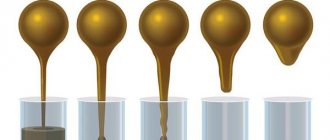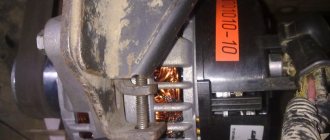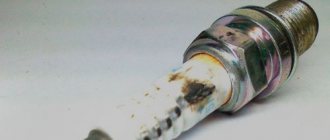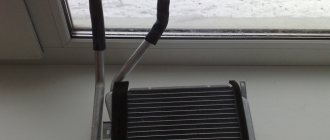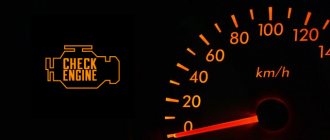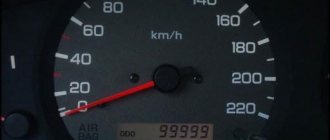The main reasons for high fuel consumption on the Lada Kalina
There are quite a few reasons, but in this article we will try to consider them all. This is primarily due to improper operation of the vehicle and untimely maintenance. So, what are the reasons for the high fuel consumption of the Lada Kalina:
It's time to change this air filter
The photo shows a not very dirty BDZ, it can be worse
All these reasons can be a consequence of increased fuel consumption on the Lada Kalina.
How to diagnose problems
13.3 liters per hundred is a lot even for the economical Kalina, even for driving in traffic jams
First, check whether the consumption data on the on-board computer screen is correct. To do this, compare its data with your gas stations! Fuel up to full, record the mileage until the next gas station, and find out the real fuel consumption of your car.
Diagnostics of faults should be carried out step by step until the cause of failure of a particular part that affects the increase in consumption is determined:
- Checking the air filter. If there are brown deposits on it, it should be replaced. Scheduled replacement is carried out every 20,000 km.
- Fuel leaks or smell indicate a leak in the power supply system.
- Spark plugs should be checked on a special stand. It is also necessary to clean the carbon deposits and set the gap. If you need to replace the spark plugs.
- It is easy to diagnose a throttle malfunction; you just need to press the gas pedal with the ignition off. If there is jamming, then there is a system malfunction.
- The Check signal means a malfunction in the idle circuit.
- It is worth removing the throttle corrugation and shining a light into the damper to check for any cracks.
- It's worth checking the injectors.
- It's worth checking the ignition coils.
Ignition coils are marked with a circle
While checking the compression of the Kalina engine
Elimination methods
To troubleshoot problems, it is necessary to replace broken or failed parts. If the malfunction cannot be resolved, you should contact a fuel specialist; you may need to adjust the injection.
Another troubleshooting option is to flash the control unit firmware. For the Lada Kalina, this is normal practice when errors occur in the ECU (error 4 is a fairly common occurrence). This malfunction can be treated by adding new software to the unit.
Functional features
The main purpose of the sensor discussed here in Lada Kalina is to measure the main parameters in the intake system and adjust the speed. This is done by sending pulses to the engine control module, which, based on the data received, adjusts the volume of injected fuel.
Due to the fact that the specified idle speed regulator acts as an actuator, determining its failure is a very difficult task. This is due to the lack of a useful self-diagnosis function in the Lada Kalina.
The device is designed to control the volumes of air that are directed through the intake tract into the combustion chambers of the engine. Here, the air mass (also measured by the mass air flow sensor) enters through a special channel, bypassing the throttle valve, which is closed in idle speed mode.
This idle speed regulator is involved in warming up the 8-valve engine, ensuring that the unit reaches its operating temperature in a timely manner.
When the ignition is turned on, a rod “crawls out” from the regulator and reaches a specially designed hole. This is called the initial position of the sensor.
Next, we outline the primary functions of this device:
- adjusting the optimal air mass;
- participation in warming up the engine 8 valves;
- determination and adjustment of the number of revolutions.
conclusions
If the on-board computer shows significantly more than 8.5 liters (and this is the average consumption in mixed mode), then this is a reason to think about the proper operation of the engine and its systems
If an increase in fuel consumption is detected on the Lada Kalina, the malfunction should be immediately diagnosed and repaired. There were cases when consumption reached 20 liters and only after that did motorists begin to do something. If the owner of a Lada Kalina cannot detect the fault himself, then it is worth contacting a car service center. The consequence of increased consumption may be increased wear of the elements of the power unit, which can lead to unplanned overhauls.
Source
Low or uneven tire pressure
But if you guarantee that the car has not been overloaded, you drive in the most economical manner possible, the car does not have any additional bells and whistles like a baby carrier or a roof rack, but there is still an overrun, then diagnostics are needed to identify the cause of the malfunction. Absolutely all Lada Kalina owners are interested in such an indicator as the fuel consumption of their car, and surely each of us wants to make it less.
About the real fuel consumption of Lada Kalina
The fuel consumption indicated by the manufacturer may differ significantly from the readings observed by the owners of this car. Let's find out what gasoline consumption of the Lada Kalina is indicated in the instruction manual and what real figures are observed by car enthusiasts.
The technical characteristics of Kalina (sedan, station wagon, hatchback or sport) indicate “ Fuel consumption by driving cycle, l/100 km ”:
- for Kalina 1.4l is equal to 7.0;
- for Kalina 1.6l from 7.2 to 7.8.
To determine the real fuel consumption on Kalina 1.4, we analyzed reviews from owners. As a result, it turned out that:
- Consumption in the city ranges from 6.8 l/100 km to 11.5 l/100 km. The average is 8.47 l/100 km.
- Highway consumption ranges from 5l/100km to 8.5l/100km. The average is 6.18 l/100 km.
- The combined cycle ranges from 6.5l/100km to 8.3l/100km. The average is 7.29 l/100 km.
Fuel consumption for Kalina 1.6 will be slightly higher, the average is 9/6.8/8 for city/highway/mixed. Why do some people have high fuel consumption in their Lada Kalina, while others have much less? There may be several reasons, here are the main ones:
- Driving style . The differences in fuel consumption during quiet driving and active driving (with sharp braking and acceleration) can be significant (10-25%).
- Gasoline quality . Gasoline consumption of AI 95 will be less than AI 92 (article).
- Seasonality . Kalina's consumption per 100 km. in winter it will be more due to slippery roads and warming up. The difference with summer will be 1-2 liters.
- Traffic jams . Even a small traffic jam can increase gasoline consumption by 2 liters.
- Air conditioner . When the air conditioner is turned on, Kalina's consumption increases by 0.5-1 liters.
- Kalina malfunctions . If fuel consumption on Kalina has increased significantly, then you should diagnose the car and determine the reasons for the high gasoline consumption.
New bodies and engines
A considerable proportion of owners are prone to driving at high speeds and aggressive driving style. Fuel consumption inevitably increases, and the face of the temperamental driver becomes covered with surprise, turning into despondency.
Low or uneven tire pressure
I think it’s no secret to anyone that not only the maneuverability and behavior of the car on the highway, but also the fuel consumption of your Lada Kalina depends on the pressure in the wheels. Before filming this video, which is located above, I drove 140 km to the village: so then, at the same speed, the consumption was about 6.5 liters on the same section of the road, but the right front wheel was lowered to 1 atmosphere, here is a real example of this , why did my Kalina eat more then?
Naturally, in winter on a snowy road, the needle on the gasoline gauge will tend to zero faster than in dry weather and on summer tires. Heavy snow or rain, wind - all this negatively affects fuel consumption, as they create enormous resistance to the car body. In winter, of course, you have to spend even more money on gasoline, since you have to constantly warm up the engine.
Factory standard fuel consumption indicators for Lada Kalina
There are four main models of the Lada Kalina passenger car:
- sedan - has a closed body, with 2-3 rows of seats for the driver and passengers, the trunk is separated from the car interior, there is no lifting door in the rear wall;
- station wagon - has a closed cargo-passenger body, one of the sedan variants, which has an enlarged luggage compartment, is equipped with a lifting door in the rear wall;
- hatchback - has a body with 1-2 rows of driver and passenger seats, with a shortened rear overhang (hence the name - “hatchback” means “short”) and a smaller luggage compartment, equipped with a lift-up door in the rear wall;
- sport - is a sports version, which is equipped with a number of special parts - a bumper, an exhaust pipe tip, sports pedals, alloy wheels, a SAAZ Sport sports suspension, front and rear disc brakes, an original reinforced gearbox.
As you can see, the main difference between each model is its body type. Gasoline consumption (unleaded AI-95) is calculated in liters over a driving cycle, which is 100 kilometers.
In this case, the following parameters of the vehicle itself are taken into account:
- Engine size (Lada Kalina comes in two types - 1.4 l and 1.6 l).
- Number of valves (for Lada Kalina - 8 and 16).
Experts have prepared an information table that shows the factory fuel consumption indicators for each model of the Lada Kalina passenger car, taking into account the mandatory parameters.
The manufacturer sets the standards for digital fuel consumption indicators for each Lada Kalina model based on the results of test runs of passenger cars on a special track. But on the track, driving conditions are reduced to ideal, and the car is driven by an experienced driver. In real conditions, everything becomes much more complicated. In addition, the speed indicator during real driving is not always within the required limits - from 100 km/h to 120 km/h. This is due to the fact that some drivers do not recognize the established framework for optimal driving of a Lada Kalina car, which significantly affects fuel costs.
DMVR sensor malfunction
This problem was on my previous VAZ 2112 car, where this mass air flow sensor constantly sent an error to the on-board computer and the instantaneous flow increased immediately from 0.6 to 1.3 liters per hour when the engine was idling. I had to constantly reset the error. So keep an eye on and replace the air filter more often than written in the operating instructions, thereby you will extend the life of the mass air flow sensor for many years.
Post edited by Dove: 08/21/2010 - 20:02
- true alchemist.
- Group: Users
- Posts: 3,027
Dove (Today, 11:46) wrote: check the iron, adjust the valves, use a gas analyzer to check the real composition of the mixture and the quality of combustion, if everything is OK, then it’s not the engine Aleshka87 (Today, 14:30) wrote:
- Five thousand meter
- Group: Users
- Posts: 24,413
peskovvs (Yesterday, 21:57) wrote: Iron - in the sense of sensors?
- ordinary user
- Group: Users
- Posts: 227
Dove (07/23/2010 - 10:26) wrote:
- recently on the forum
- Group: Beginners
- Posts: 3
Dove (07/22/2010 - 10:46) wrote: for a 1.6 engine, 8 valves, 9 and even 10 liters in the city is normal, on the highway mine eats, depending on the movement, - 5.9/7.1 liters per hundred.
- ordinary user
- Group: Users
- Posts: 227
- true alchemist.
- Group: Users
- Posts: 3,027
Dove (07/23/2010 - 11:26) wrote:
- Five thousand meter
- Group: Users
- Posts: 24,413
So I got my hands on the diagnostic equipment. These are the errors generated by the controller:
P0117-Low signal level of the coolant temperature sensor circuit P0102-Low signal level of the mass air flow sensor circuit P0171-Fuel supply system is too lean at its maximum enrichment P0171-Fuel supply system is too lean at its maximum enrichmentThe first error, as far as I remember, popped up during the service before last. along with an error in turning on the cooling fan. The servicemen changed the fan relay (although I knew about the problem and had changed the relay myself shortly before). They told me about the last error at the last maintenance, suggesting an air leak.
Attached is a log of the trip made by the kwp program, if it can provide additional information. I can make another log tomorrow.
- At work
- Group: Users
- Messages: 22,035
- Five thousand meter
- Group: Users
- Posts: 24,413
Yuri Petrovich (Today, 20:52) wrote: They also told me about this at the last maintenance. But the consumption was then normal. What is the reason for the high consumption?
DMRV died? Or are errors 102 and 171 related?
PS. By the way, with the suction, how do you find the place of the suction?
- true alchemist.
- Group: Users
- Posts: 3,027
Dove (Yesterday, 21:22) wrote: by ear, pinching the vacuum hoses, pouring water, water or carburetor cleaner on suspicious joints, multiplicative correction 1.24 all the way in the plus, 100% suction
- Five thousand meter
- Group: Users
- Posts: 24,413
peskovvs (07/28/2010 - 00:00) wrote: OK, we'll look for a leak.
peskovvs (Today, 01:00) wrote: That is. with the engine running? And if the engine operating mode changes, then look for the problem at this junction?
I'm posting the second log. Today, by the way, the dzhekichen has not been burning since the morning, although I did not throw it off yesterday. I also reset the tripcomp and at the end of the trip it showed an average consumption of 7.7 liters, which is already normal. And the dzhekichen caught fire again, the moment of switching on is visible on the log. Post edited by Dove: 07/28/2010 - 09:23
- At work
- Group: Users
- Messages: 22,035
- Five thousand meter
- Group: Users
- Posts: 24,413
Yuri Petrovich (Today, 16:45) wrote: Yes. It seems like there are no viburnums without a cathode collector (excluding those modified with a crowbar).
- At work
- Group: Users
- Messages: 22,035
- true alchemist.
- Group: Users
- Posts: 3,027
- Megatheronosaurus
- Group: Users
- Posts: 5,366
peskovvs (28.07.2010 — 23:44) wrote:
- ordinary user
- Group: Users
- Posts: 193
Dove (07/22/2010 - 10:46) wrote:
- true alchemist.
- Group: Users
- Posts: 3,027
glob (Yesterday, 23:16) wrote:
this is due to neglect and “old age” - for example, the air flow sensor was killed by oil, dust and high mileage, the injectors were filled with low-quality fuel (with water or something else), the filter was defective - it was torn. I doubt that a relatively “fresh” viburnum will suffer from the same bunch of malfunctions, it has its own problems , for example with a catenary collector (see above)
Real fuel consumption of Lada Kalina (according to reviews from car owners)
Many car owners of the Lada Kalina passenger car complain that in reality, gasoline consumption indicators differ from those specified by the manufacturer. For comparison, let’s look at another information table prepared by specialists taking into account feedback from Lada Kalina car owners.
When comparing two information tables, it is clear that the real figures are indeed higher than the stated factory fuel consumption standards for the Lada Kalina. What are the reasons for this discrepancy between the figures?
The main reasons for the difference between the gas consumption figures for the Lada Kalina passenger car - real and factory ones
There are several reasons for the discrepancy between the actual gasoline consumption figures of the Lada Kalina and the factory standards. Experienced car enthusiasts identify typical ones among them:
- Type of terrain - driving in the city, on the highway, off-road or mixed type of road (the more complex the type of road, the higher the fuel consumption).
- The driver's driving style is slow driving, fast driving, with sharp acceleration, with sharp braking (the more complex the driving style, the higher the gas consumption).
- The quality of the fuel used - AI-95 gasoline is consumed less than AI-92 gasoline.
- Time of year - in winter, fuel consumption rates will be higher, this is affected by icing of the road surface and frequent warming up of the vehicle itself.
- Traffic jams - due to slow driving and frequent braking, gasoline consumption increases by almost several liters.
- Using additional car devices (for example, air conditioning) – with devices constantly on, gasoline consumption will be 0.5-1 liter more.
In addition to the reasons listed, fuel consumption can be affected by various breakdowns of the vehicle itself:
- incorrect readings of the electronic engine control system due to sensor errors - temperature, mass air flow, oxygen, throttle position;
- abnormal pressure in the fuel system;
- internal combustion engine injector malfunction;
- failure of the catalyst;
- dirty air filter.
To install them, the car owner needs to diagnose the Lada Kalina passenger car. After diagnosing and identifying the causes of malfunctions, the vehicle is repaired.
Driving style, operating conditions and tire pressure • First cars
| Tips and ways to reduce fuel consumption on a Lada Kalina An injector, due to dirty fuel or water in the fuel, or wear and tear and basic aging, can reach a state where its mechanical part begins to leak excess fuel when the injector is closed. During the winter season, fuel consumption rates will be higher; this is affected by icing of the road surface and frequent warming up of the vehicle itself. |
| Lada Kalina: features of fuel consumption, how it is Absolutely all Lada Kalina owners are interested in such an indicator as the fuel consumption of their car, and surely each of us wants to make it less. If you want to reduce fuel consumption as much as possible, then use a simple rule: do everything possible to keep the brake pedal in one position. |
- Peter, Tyumen. I bought a Lada Kalina Cross in 2015. This is one of the few representatives of the domestic automobile industry with horsepower exceeding one hundred. And indeed the car turned out to be lively; my hatchback can compete with some foreign cars when driving on open sections of the road. The other side of the coin is gasoline consumption in the city; I did not observe the promised 8.4 liters both during the run-in and after it. This engine consumes at least 10 liters per 100 km of road with traffic jams.
- Lev, Voronezh. My wife does not know how to use a manual transmission, so I had to buy a car with an automatic transmission system. The choice fell on the second generation Lada Kalina 2014. Naturally, I understood that, as with any automatic, fuel consumption would be higher than with a manual, and that’s what happened. My figures in the city, judging by the on-board computer data, are usually within the range of 11-12.5 liters per 100 km of traffic. This sad moment worsened three years after the purchase, the injector with nozzles became clogged, for some reason this happens more often on the 8-valve Kalina than on other engines.
- Taras. Moscow. I never regretted buying Kalina Cross for my baby; she often helped me out in situations when more expensive foreign cars failed. And when breakdowns happened, and this happens, the repairs did not cost me much at all. Of course, it cannot be considered a plus that the Lada Kalina has fuel consumption per 100 km, with a power of 106 hp. higher than foreign cars of the same class. In my case, in the city, I fill at the rate of 12 liters, but on the highway the situation changes dramatically and costs drop to 7.5 liters.
- Ilya, Odessa. For a car with such a price, many disadvantages are forgiven, but they exist. First of all, this is the fuel consumption of the Kalina; it can sometimes be compared with the performance of some SUVs. Regular failure of components and parts is also somewhat annoying, but the main thing for me is road noise. Compared to foreign cars, you feel as if you are driving without doors. Of course, there are also advantages: it is inexpensive to service and parts are always easily accessible.
- Andrey, Nakhabino. I don’t understand why people have so much hatred for the Lada Kalina, because you can find out everything about it before buying, and there are plenty of disadvantages, but there are also advantages. Mostly they complain about high gasoline consumption, but you can always install LPG and save money. The metal on the body is good and thick, its quality cannot be compared with Chinese tins. It’s just a pity that the quality of the factory paint is rather weak, and over the years bubbles appear in some places.
How to tighten the electric power steering rack?
The appearance of a knocking sound in the operation of the electric power steering is associated with the need to tighten the steering rack.
How to do it right:
- First you need to disconnect the battery; to do this, disconnect the terminals from it. Unscrew the battery mount; to do this, you need to unscrew two more nuts located at the edges. After this, the battery is removed and put aside.
- Then you need to lift the plastic stand, there are four more screws under it, they can also be unscrewed.
- Having done this, it is necessary to move this stand forward until the platform is disconnected from the air filter housing retainer pad. After this, the trim can be moved back, this will provide freer access to the rail itself.
- At the next stage, you will need to crawl your hand under the rail. Directly below it, as shown in the photo, there is a rubberized cap; it will need to be removed, this will allow the key to access the adjusting nut.
- To perform adjustment work, you will need a special wrench to tighten the rack; without it, the adjustment procedure will not be possible. Using this wrench, you need to crawl under the car rail to install the tool in the required hole.
- When adjusting, be careful not to overtighten the rack. If its tightening is very strong, then when cornering the rack will bite, and this, in turn, may affect the safety of movement. The angle of adjustment is always different, it depends on how much the nut is loose, but usually when performing such work the nut is tightened by approximately 30 degrees. This should be enough to get everything right. After the adjustment is completed, it will be necessary to check that this task was performed correctly. That is, you will need to make sure that the steering wheel turns normally to any position all the way and there is no knocking. If the knock remains, then the adjustment continues.
Photo gallery “Adjusting the steering rack”
1. Slide the stand and detach it.
2. In this place under the rail there is an adjusting washer.
3. Adjustment is made with a special key.
4. Location of the adjusting nut.
Second generation Lada Priora 16 MT 98 hp
| Fuel consumption of Lada Kalina 8 and 16 valves per 100 km: real indicators The price of such fuel may be higher, but due to better quality and a higher octane number you will be able to reduce consumption and save on repairing fuel equipment. There was also a choice of transmission options; as before, it was possible to purchase a car with a manual 5-speed gearbox or with a 4-speed automatic. |
- The pressure in the fuel system is no longer stable and sufficient. This means that the nozzles or filters may be clogged, or the pump simply has a lack of service life.
- The catalyst in the same system is clogged.
- The air filter is clogged.
- The motor is constantly at an inappropriate temperature: too cold or overheated.
- Other problems appeared inside the car.
- Winter season. During periods of bad weather and cold weather, the car is especially vulnerable.
- The driver has a habit of accelerating and braking quickly when driving a vehicle.
- Unsuitable or low quality gasoline is used.
- The air conditioner or other electrically powered device is turned on.
Second generation
For the second generation, factory standards differ from real indicators, and they have increased compared to the first. The average city consumption is 11.4 liters, but on the highway it is almost 9 liters. Thus, it turns out that the average consumption will be almost 10 liters, which is significantly more than indicated in the service documents.
Fuel consumption depends on the technical condition of the car. The worse the condition, the higher the fuel consumption. Let's look at the main indicators that affect how much a car “eats”:
- Ignition system. Incorrect settings may result in the vehicle consuming more fuel.
Ignition coils are marked with a circle
- The fuel filter plays a significant role. Element contamination also affects consumption. It is located under the bottom of the car.
New SCT fuel filter compared to the fuel filter removed from the car
- Incorrect throttle operation.
- The quality of the fuel that the owner fills directly affects fuel consumption.
- Condition of combustion chambers.
- Driving style also affects consumption.
All these factors are directly related to fuel consumption on Kalina.



